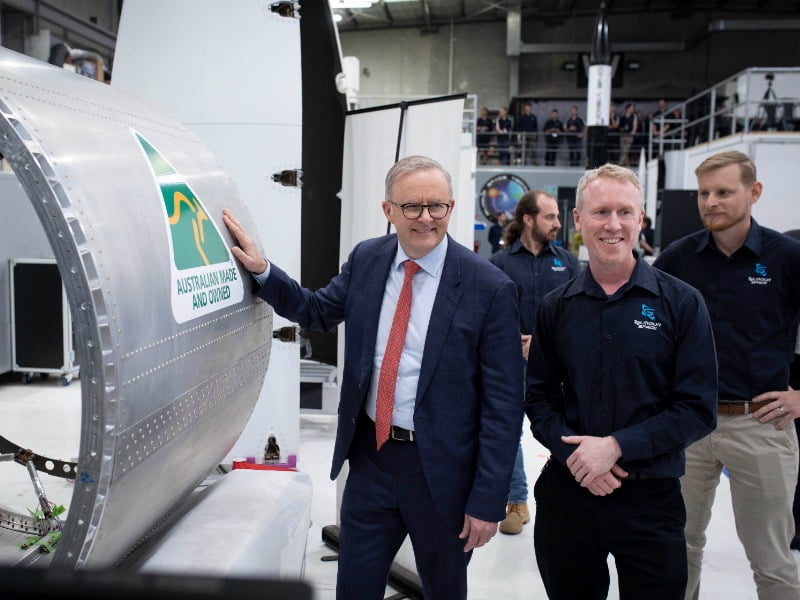Activity at the Bowen Orbital Spaceport has ramped up in the new year, with final construction and assembly of launch site infrastructure underway ahead of the maiden launch of the maiden flight Gilmour Space Technologies Eris rocket.
There remains a couple of challenges to overcome – not least obtaining its launch licence from the Australian Space Agency – but the company is hopeful that the first flight of the three-stage orbital vehicle will take place in late March or early April.
InnovationAus.com will be providing as countdown of fortnightly updates in the lead-up to the launch, perhaps increasing the frequency of these news stories as the activity warrants. We expect to have a reporter on the ground at Abbot Point launch site just north of Bowen in the lead-up to take-off.
Some 30-plus staff returned to spaceport in the new year and will be based there through until launch day.
This weekend the company will start performing water deluge tests. As the name suggests, water deluge systems pour large volumes of water into the exhaust streams of the rockets at launch.

This reduces the thermal load, reducing the risk of damage to site infrastructure (and rocket) from the extreme temperatures at launch.
Next week, the company expects to be able to tests its transport erector arm – the large-scale machine that will transport the rocket from its assembly facility to the launch pad and lift it into a vertical position. Initial testing on the erector arm will involve the rocket!
Last Wednesday, the company carried out a launch rehearsal within its Mission Control Centre at Bowen, the first of a series that have been planned for the coming week, according to Gilmour Space director and head of communications Michelle Gilmour.
The rehearsals are dry, with the so-called wet testing – where the various liquids are pumped on board as if the rocket were about to launch – not taking place until right at the end of the process.
The wet testing makes sure the complex fluids rack connecting to the rocket is functioning properly and that there are no leaks.
Ms Gilmour said they expect to have the rocket vertical in mid-March, when the company will do a full launch vehicle test, pumping fluids in (and out) of the rocket and doing a launch rehearsal with the vehicle right down to T-zero.
She said that although the Bowen site had not been directly impacted by tropical cyclone Jasper that hit Queensland coast further north during December, the storm did cause delays to delivery of some big items for the ground support systems.
Some of the work on those systems that was to have taken place before Christmas was help over until this month.
Most importantly, the company is still waiting for its licence approval from the Australian Space Agency. Regardless of readiness, nothing happens until that licence is granted.
In the meantime, the company is in the middle of a hiring spree, with 22 open positions currently being advertised, with Gilmour seeking everything from avionics engineers – with a substantial number of roles to fill – to welders, CNC machinists and manufacturing supervisors.
The company is top-heavy in highly-skilled STEM-based roles, but it is also looking for booking and specialist procurement skills – and as the company moves from its test-phase to volume manufacturing is looking to fill specialist advanced manufacturing roles.
Gilmour currently employs about 180 staff across two sites on the Gold Coast and now also the Bowen Orbital Spaceport.
The company also received a $17.6 million, 18-month contract with the Department of Defence for launch and engineering services that runs until the middle of next year.
Finally, interest in the Eris test flight is gathering momentum. Gilmour Space has been fielding increasing numbers of email and phone inquiries from people that want to visit Bowen to watch the launch.
“I am getting a lot of interest from people all over Australia, from people who want to travel to Bowen specifically to see this launch, who see it as a historic event or who are space [enthusiasts],” Michelle Gilmour says.
“Our response to that is to say please don’t come for the first launch. It’s a test flight and there is almost guaranteed to be delays and [mission] scrubs,” she said. “And that makes planning very difficult [for people].”
“We are saying hold on and wait until our second launch which will come later this year – and then you should come and visit and watch a rocket get launched.”
Gilmour Space Technologies chief executive Adam Gilmour and co-founder James Gilmour met with representatives of the Bowen business community in December to talk through the phenomenon of ‘launch tourism’ that has followed the success of commercial rocket companies.
A big SpaceX launch can attract many tens of thousands of visitors to watch the lift-off. It is hard to gauge how many tourists a local orbital vehicle launch might attract. But as the frequency of launches accelerates, it could be expected to be in the thousands.
Do you know more? Contact James Riley via Email.

